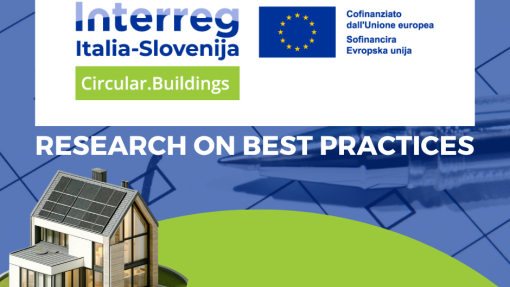A wealth of operational best practices, strategic drivers for the entire supply chain (reverse logistics, industrial symbiosis, BIM, material banks, digital platforms) and a focused look at the Italy–Slovenia cross-border context.
After a year of work, the University of Udine (Department of Engineering and Architecture – DPIA) has published a comprehensive analysis of circular economy strategies and best practices applicable to the construction sector, with a particular focus on the impact on the cross-border area. The research reconstructs how to integrate the principles of the circular economy throughout all stages of a building's life cycle, from design to end of life, highlighting obstacles, levers and concrete opportunities for businesses, professionals and public decision-makers.
WHAT YOU WILL FIND IN OUR RESEARCH
In detail, the UniUd team has:
mapped the construction supply chain management systems and related circularity drivers (forward/reverse logistics integration, industrial symbiosis, material & component banks, digital platforms, BIM and blockchain), proposing a practical framework for moving from linear chains to circular “cradle-to-cradle” supply chains.
conducted a scientific review (Scopus, Science Direct) which, starting from 1,252 contributions identified with targeted keywords, selected 119 papers that are truly relevant to circular best practices in the construction sector, highlighting the sharp increase in publications since 2023.
identified and summarised in operational sheets the most mature best practices that can be transferred to the cross-border context (Italy–Slovenia), making them quickly accessible to stakeholders through descriptions, expected benefits, enabling conditions and support tools.
analysed the cross-border building stock and the most common types, to understand where and how the selected practices can generate the greatest impact in terms of waste reduction, resource savings, extension of useful life and emission reduction.
BEST PRACTICES: A READY-TO-USE TOOLBOX
Among the key practices identified – organised to maximise value throughout the life cycle – we highlight just a few of the most relevant below, noting that in addition to finding further good practices, the research also provides practical, operational but in-depth technical data sheets for each of them:
Material efficiency-oriented design involves the adoption of design and construction techniques that minimise the production of construction and demolition waste (C&DW), but above all limit or eliminate the waste of resources such as energy and water, particularly during the construction phase.
Material circularity: this involves limiting the use of virgin raw materials and increasing the reuse of building components that are no longer used or recycled materials, at least to a certain percentage.
The use of bio-based materials: the use of bio-based and natural materials, such as wood, bamboo and raw earth, is preferable, where possible, to materials that cannot be completely recycled, such as cement conglomerates. Once discarded, these materials are naturally biodegradable and can be used to create compost to fertilise productive land
The use of low-impact materials: This good practice consists of abandoning fossil and non-renewable sources, but also those materials whose extraction, processing and transport have a significant impact in terms of resource consumption and environmental pollution.
Design for Disassembly or Design for Deconstruction is a design practice that involves designing the building, right from the initial stage, with its end of life in mind, i.e. adopting solutions and drawing up a detailed plan for dismantling the structure into its various components
Designing a building for adaptability and flexibility means that the end of its life does not have to coincide with the end of its use. Furthermore, following careful initial design, it allows for changes and variations to its basic configuration with reduced need for resources and money.
Participation in and/or creation of online platforms and databases, where it is possible to collect information on the materials used in different buildings, facilitating decision-making processes and the assessment of circularity, but also providing an overview of materials or components that have been discarded from buildings and that could be useful to other designers or construction companies, in order to promote their reuse.
DOWNLOAD THE RESEARCH AND PARTICIPATE IN PROJECT ACTIVITIES
The research is available in the Circular.Buildings project website.
To directly receive the research on your email please write an email to: circular.buildings@ecipa.eu.

